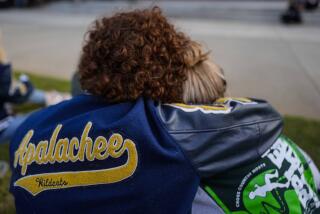The New School Dance
- Share via
EDITORS: Upcoming shortly is a 3rd Ld-Writethru to UPDATE with witness telling TV station he saw student gunman smiling while firing shots. The AP.
--An Associated Press advisory distributed Monday morning in the aftermath of the Santee school shooting.
*
On a cold January morning in 1979, in a suburban San Diego neighborhood not far from Santee, a 16-year-old girl stood at a window of her home with a .22-caliber rifle that she’d been given for Christmas. Brenda Spencer took aim at the elementary school across the street and opened fire. She shot and killed the principal and a custodian. She wounded eight students and a police officer.
She was, officers conceded after her surrender, “a pretty good shot.” They also said she apparently had been “under a lot of pressure.” Early in the siege, the teenage sniper had been reached by a newspaper reporter randomly calling houses in the neighborhood in search of eyewitnesses. Why was she doing this? Spencer was asked.
“I don’t like Mondays,” she replied, “and this livens up the day.”
And now 22 years later, another Monday morning, another school shooting, this one just as senseless as Brenda Spencer’s blue Monday attack on Cleveland Elementary. There was, however, a difference between the two incidents. Back in 1979, a school shooting still carried the shock of novelty.
*
After Stockton and West Paducah, Ky., after Jonesboro, Ark., Springfield, Ore. and, most especially, Littleton, Colo., the early bulletins about another eruption of schoolyard gunfire do not so much elicit surprise anymore as they do the contempt that comes of familiarity. It’s as if the same grotesque play has been put on tour--the same choreography of terror, the same haunting script, the inevitable images of frantic parents, of teenagers standing in circles, sobbing, of impromptu monuments of flowers and stuffed animals.
On Monday the production came to Santana High School in Santee. Students offered stories that were pathetic, heart-wrenching and, again, maddeningly predictable. They talked about fallen friends and narrow escapes and missed warning signals. They delivered for reporters obligatory bits of twisted detail--how, for instance, the little gunman seemed to smile as he blazed away with his big pistol.
A profile of the assailant as a troubled young teenager quickly took shape; this, too, stuck to the familiar plot lines. Fifteen-year-old Charles Andrew Williams was picked on all the time, one classmate recalled, “because he was one of the scrawniest guys. People called him freak, dork, nerd, stuff like that.” His skateboards had been stolen. He had been beaten up at a dance. He had boasted that he was going to bring a gun to school, but who would believe him? He was always clowning around.
On cue would come the community reaction, the expressions of shock that it had happened, not somewhere else, but in Santee, a town described by its mayor on national television Monday night as being about “Little League and soccer fields and the Fourth of July. If it could happen to Santee,” the mayor said. “It could happen anywhere.”
*
Now will follow the equally predictable rounds of public discourse. There will be renewed calls for tighter control of guns, a course which seems sensible enough given the role all too available firepower always plays in these incidents. Gun control opponents will counter that there are plenty of gun laws already, and their failure only proves that laws won’t work.
The culture warriors will mount a charge. Almost without question it will be learned that the young Williams listened to weird music or visited ghastly chat rooms. Guardians of civil liberties will point out, though, that many more children listen to the same songs and make the same stops on the Internet without turning schoolyards into killing fields. Preachers will advocate wrapping teenagers in love; politicians will talk about dispatching more of them to death row.
Statisticians will step forward: For all the attention raised by these horrible events, crime rates are falling and campuses are safer now than they have been in a long time. And so it will go until at last all the words have been spoken, all the lines recited, at which point everybody will, as the saying goes, “move on.”
Until the next time.
In the end, I suppose, it’s become almost like living in earthquake country. With quakes, all one can do is secure the foundation, strap down the water heater, and hope--aware that they can strike anytime, anywhere, yet comforted by the knowledge that, usually, they don’t.



